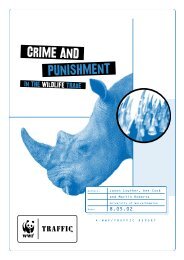Deeper Luxury Report - WWF UK
Deeper Luxury Report - WWF UK
Deeper Luxury Report - WWF UK
Create successful ePaper yourself
Turn your PDF publications into a flip-book with our unique Google optimized e-Paper software.
Criteria include topics such as equal opportunity and<br />
environmental policies, against which companies are<br />
graded from poor to exceptional. <strong>WWF</strong> turned these<br />
into numerical scores, with each criterion given equal<br />
weight in making up the total score. (In the absence<br />
of a stakeholder process to determine the relative<br />
importance of different issues, any weighting of the<br />
criteria would be arbitrary and not credible. 118<br />
However,<br />
we did correct bias introduced by the unequal numbers<br />
of sub-criteria within each of the four principal areas.<br />
This ensures that each area accounted for 25% of<br />
the 50 points available for this half of the index –<br />
a maximum for each, then, of 12.5 points.)<br />
For the second category, data was sourced from<br />
Covalence, a Geneva-based research house. Covalence<br />
documents thousands of positive and negative news<br />
stories about companies in English, French, Spanish,<br />
Italian and German, then codes and synthesises them<br />
into rankings. 119<br />
Its 45 criteria cover working conditions<br />
and the impacts of production, products and institutions.<br />
Covalence’s search generated 512 news stories which<br />
were analysed and coded as either positive or negative.<br />
<strong>WWF</strong> weighted the result so that each company obtained<br />
a comparable score out of 50.<br />
The scores for EIRIS and Covalence were then added,<br />
to create a total maximum possible score of 100.<br />
This creates a ranking of the self-reported performance<br />
Table 1: Score card – grades and corresponding scores<br />
Grade Score Grade Score<br />
A + 90 - 100 C + 67 - 69<br />
A 85 - 89 C 63 - 66<br />
A- 80 - 84 C- 60 - 62<br />
B + 77 - 79 D + 55 - 59<br />
B 73 - 76 D 50 - 54<br />
B- 70 - 72 F 0 – 49<br />
and public reputation on corporate performance on<br />
environmental, social and governance issues. Each<br />
company’s score out of 100 is expressed in our ranking<br />
as a grade between A+ (best) and F (worst) according<br />
to the scale in Table 1. The results are shown in Table<br />
2, and presented graphically in Figure 3.<br />
Table 2: Scores<br />
Group Covalence EIRIS Total Rank Grade<br />
L’Oréal 38.5 30.0 68.5 1 C +<br />
Hermès 50.0 17.9 67.9 2 C +<br />
LVMH 37.2 29.9 67.1 3 C +<br />
Coach 50.0 16.2 66.2 4 C<br />
Tiffany 47.8 11.9 59.7 5 D +<br />
Swatch 38.9 13.8 52.7 6 D<br />
PPR 21.3 30.3 51.5 7 D<br />
Richemont 35.5 15.2 50.6 8 D<br />
Bulgari 20.0 17.6 37.6 9 F<br />
Tods 25.0 9.9 34.9 10 F<br />
The highest grade reached by any luxury conglomerate<br />
is C + , which is achieved by three of the four companies<br />
based in France: L’Oréal, Hermès and LVMH. Companies<br />
based in Italy come bottom, with F grades; of the top 10<br />
luxury conglomerates, they have the worst self-reported<br />
performances and overall media reputation for good<br />
governance, and social and environmental responsibility.<br />
The combined scores mask some of the differences in<br />
self-reported performance, as companies such as Hermès<br />
and Coach appear better at having avoided negative<br />
criticism from civil society and the media. Figure 4<br />
illustrates the level of media attention given to brands<br />
between 2001 and the end of 2006, as well as the<br />
general nature of that attention.


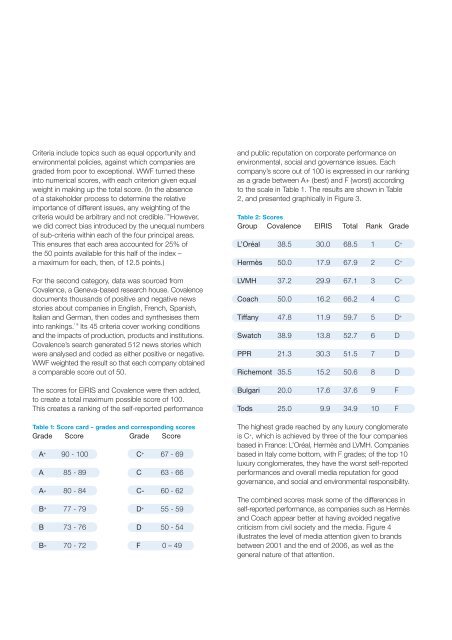
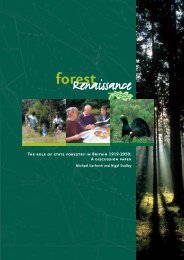
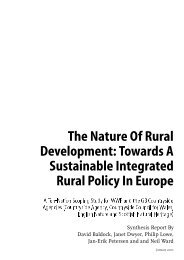
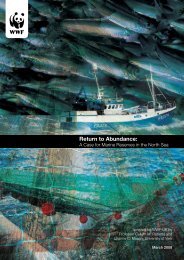
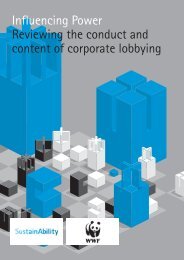


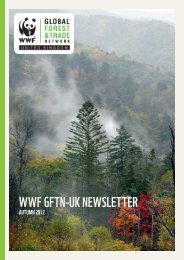
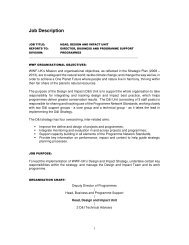
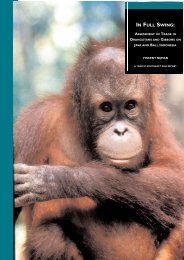
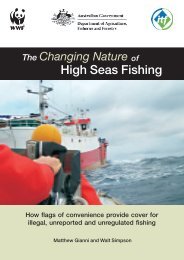
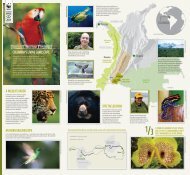
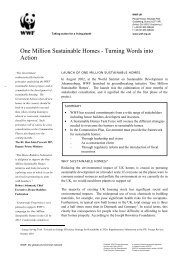
![[PDF] Causes for concern: chemicals and wildlife - WWF UK](https://img.yumpu.com/31929970/1/184x260/pdf-causes-for-concern-chemicals-and-wildlife-wwf-uk.jpg?quality=85)
